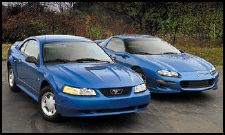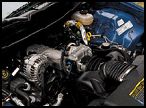|
Camaro vs. Mustang. Again. 
Camaro vs. Mustang. Again. Chevy Camaro Z28 vs. Ford Mustang GT: It doesn't get much more all-American than this. By TONY SWAN Photos by AARON KILEY |
|
|
|
|
|
Harvard versus Yale is fine if your notion of a great American rivalry is rooted in stick-and-ball stuff. But if you're a car guy—sorry, car person—it just doesn't get any more all-American than Camaro vs. Mustang. On street, strip, or road circuit, this has been a renewable competitive resource since the first Camaro made its belated appearance in September of 1966. We say belated because by that time the Mustang had been on sale for almost two and a half years, and there were well over a million of 'em galloping around America's highways and byways.
 Since then, we've seen these two square off in a variety of Car and Driver performance shootouts, sometimes in multicar free-for-alls. As with collegiate athletic rivalries, the players have evolved as the years have gone by. But unlike college sports, Mustang-Camaro showdowns are rarely boring. Since then, we've seen these two square off in a variety of Car and Driver performance shootouts, sometimes in multicar free-for-alls. As with collegiate athletic rivalries, the players have evolved as the years have gone by. But unlike college sports, Mustang-Camaro showdowns are rarely boring.
That's certainly true of this one, particularly if you're a Mustang fan. It's been more than 10 years since Ford has managed to bolt together a regular-production V-8-powered Mustang—as distinct from the limited-production versions issued by Ford's Special Vehicle Engineering arm and marketed by the Special Vehicle Team (read: SVT Mustang Cobra)—that could hold its own in a drag race against its cross-town counterpart from Chevy. This is indeed germane, because V-8 power in a relatively lightweight two-door is the essence of the pony-car tradition, now in its 35th year. We also think this could very well be one of the last times these two rivals meet in close combat. The 2001 model year will be the last for the current General Motors F-bodies—the Camaro and the Pontiac Firebird—and at this writing, GM has no new model scheduled for the factory in Sainte-Therese, Quebec, that produces them. Predictably, Chevy insists that the Camaro name will live on, but what that name will be attached to is anybody's guess at the moment. Well, that'll be then, but this is now, and what you want to know right now is which of these quarter-horses can cover the quarter the quickest. So, buckle up, bud. 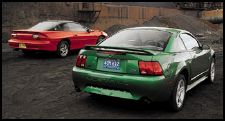
Our prime combatants (the V-6s are detailed in a sidebar) were well-equipped versions of the Z28 and Mustang GT, both 1999 models. Although a base Mustang GT and a standard Z28 are priced almost identically—$21,395 versus $21,405—our testers were separated by almost $1500—$24,341 for the Chevy vs. $22,855 for the Mustang, due to the Camaro's $1591 preferred equipment package (including power goodies, remote entry, and an alarm—all standard on the Ford). For the Camaro, 1999 isn't much of a change from 1998. The only significant update is the Z28's standard Zexel Torsen limited-slip differential. But it's a different story for the '99 Mustang, which has undergone its first serious makeover in five years. For example, although the basic shape is familiar, almost all the skin is new, be it ferrous or nonferrous (the new rear decklid is made of sheet-molded compound, a fancy way of saying plastic, rather than sheet steel). There are bigger side scoops ahead of the rear wheel wells (although their function continues to be purely decorative), a new front fascia with wraparound headlights and an expanded grille, bigger taillamps, and sharper definition to the fender flares. The widened (by 1.4 inches) rear track brings the wheels out closer to the edges of the bodywork. All in all, there's an engagingly edgy look to the new package that was missing on the previous version, as well as a suggestion of more brawn to go with it. And that's a suggestion that should be taken seriously. There are many more ponies under that resculptured hood, enough to chop the Mustang's 0-to-60-mph time to 5.5 seconds, 0.6 second quicker than the last GT to take on a Z28 (C/D, December 1993). If the Z28 hadn't posted an improvement of its own—5.2 seconds vs. 5.4 back in '93—it would have been almost a dead heat. So how'd they do that? We were less than impressed when Ford replaced the Mustang's old 4.9-liter pushrod V-8 with the current 4.6-liter SOHC V-8 in 1996. Amid the corporate hosannas lauding technoprogress, we noted that the peak output figures for the modern new engine were exactly the same as the antiquated old one's: 215 horsepower and 285 pound-feet of torque. Ford mined another 10 hp from the 4.6 last year, but that still seemed tame compared with the Z28's 305 hp and 335 lb-ft of torque. So for '99, Ford's horsepower honchos got serious. The GT version of the 4.6-liter V-8 has bigger valves, higher-lift cams with longer duration, revised intake runners, and coil-on-plug ignition. Two 3.0-inch tailpipes reduce exhaust back pressure and, almost as important, lend a throaty baritone to the exhaust note, turning out the sweetest sounds we've heard from a Mustang since the heyday of the Boss 302. The net-net: 260 hp at 5250 rpm, 300 lb-ft of torque at 4000. That increase, plus a lower 3.27:1 rear-axle ratio—standard on all '99 Mustangs—accounts for the GT's ability to stay close to its more powerful rival in short sprints. And it's a big factor in the near-photo-finish scoring of these two. But not the only factor. Second Place: Ford Mustang GT 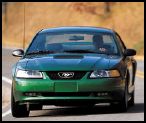
In addition to expanding the Mustang's rear track, Ford's chassis troops also increased the car's rear-suspension travel, changes that pay off in a couple of positive ways. First, the Mustang delivers a distinctly smoother ride on all surfaces. Second, and more surprising, the Mustang was very handy in our emergency-lane-change test, slashing through the cones almost 5 mph faster than the Camaro. Our test drivers' notebook remarked that the Z28's behavior was "floppy" and that there was "not much grip." Later, in a slightly shaky hand, the same author added, "Oversteers, too." In contrast, the Mustang's conduct through the cones was recorded as "very secure, no dramatics, balanced." 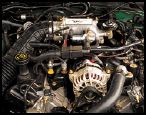
We planned to augment these observations in the controlled environment of a road-racing circuit and accordingly saddled up for a trek from Ann Arbor to GingerMan Raceway, a very thoughtfully designed (read: forgiving) new track a few miles from the eastern shore of Lake Michigan. Alas, as we drew close, the gray skies made good on their threat of rain, a gentle drizzle that lasted the rest of the day. We slithered around the track for a while, an activity that told us that even with traction control these cars tend to oversteer in damp conditions and that anti-lock braking is indeed a good thing. Duh. Since neither of these findings falls into the realm of blinding revelation, we splashed off homeward, leaving our high-speed-handling comparisons for the lightly traveled back roads we normally use for our annual 10Best competition. 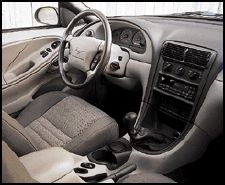
When the dust had settled, our initial impressions of the Mustang's agile handling, and its quick, accurate steering, were tempered by persistent complaints about understeer. Even though this trait reduces the chance of drivers making truly disastrous errors, it's not one that endears itself to the true enthusiast. The Mustang's seats came in for a number of negative comments—flimsy bolsters and marginal padding. We also found the action of the five-speed shifter somewhat stiff and its placement a bit too far forward. Similarly, placement of the brake and throttle pedals—too much separation, both vertically and horizontally—made it all but impossible to execute proper heel-and-toe downshifts, unless the driver happened to have an ankle equipped with an extra Heim joint or two. And we devoutly wish Ford would update this car's audio controls. The tiny buttons and the overall appearance were already old 10 years ago. On the other hand, the Mustang has some magic that the Camaro seems to lack. Although we were evenly divided on which of these two cars looked the best—the chunky, muscular style of the Mustang or the Camaro's shark shape—the folks we encountered during our two weeks with these cars didn't even want to know about the Z28. All the queries concerned the latest Mustang, and they were uniformly enthusiastic. Comments like "Wow!" and "Cool!" were heard more than once. 
Add that kind of popularity to performance that's definitely been clicked up a notch or two, plus a clear edge in comfort, and it's clear the Mustang has a new lease on life. Highs: Improved power, decisive steering, comfortable ride. Lows: Stiff shifting, so-so seats, awkward pedal layout. The Verdict: Much improved, but still playing catch-up. First Place:Chevrolet Camaro Z28 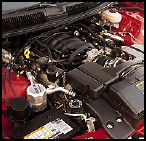
The challenge in forming a rational opinion of the Z28 lies in seeing past its prodigious power. For the uninitiated, this will probably require a minimum of two hours behind the wheel—or perhaps two years, who knows?—before some of the not-so-endearing elements become tangible through the red haze of small-block V-8 thrust. Small is a relative word here, of course. The Z28's 5.7-liter LS1 V-8—a slightly detuned version of the Corvette's engine—is small compared with GM's old big-blocks, but its displacement is vast compared with that of most passenger-car engines offered today. Only the lame-duck Rolls/Bentley V-8, the Dodge Viper's V-10, and V-12s from Lambo and Mercedes are bigger. With or without overhead cams, it's easier to get performance—particularly torque—out of bigger engines than smaller ones, which helps to explain the Z28's decided edge over the Mustang in this essential pony-car commodity. The torque curve is like the Mississippi River—broad, deep, and flat—and augmenting it with six forward gears, rather than five, doesn't hurt, either. Once the Z28 begins to assert itself, it's all over. By the time 100 mph comes up—in just 12.6 seconds—the Mustang is 2.3 seconds in arrears, and continues to fall farther behind as speeds soar. 
The bottom line: The new Mustang is surprisingly quick, but the Z28 is much quicker, with wonderful throttle response. Yes, this does tend to inspire occasional outbursts of mildly sociopathic driver behavior, but it's also a terrific ally when a passing situation suddenly turns dicey. It's too bad that Chevy doesn't seem to be able to surround this superb powerplant with a better car. Although GM has done a good job of keeping the F-car chassis viable, like the Mustang's, it's still a live rear axle setup, and it shows us, once again, that live axles have definite handling limits, particularly on bumpy roads. In this case we found that oversteer was just one injudicious stab of the throttle away, and one tester went so far as to call the Z28's handling "spooky." 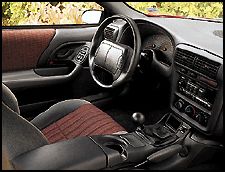
The Z28 was also a clear second to the Mustang in braking, and its ride quality wasn't nearly as pleasant when there were any kinds of lumps on the pavement. Inside, the Z28's seats got the knock—like the Mustang's, they're short on comfort and lateral support—as well as its driving position, which forced some drivers to sit with their legs splayed. There's a sense of sitting down in the middle of a big bathtub, and it's difficult to determine the exact location of the car's front corners from the driver's seat. Although it's quieter than the Mustang, there may also be those who find the Z28 to be a tad noisy, but on this issue, at least, your C/D test staff was united: The basso profundo of this engine is just this side of celestial. And anyway, if you don't like it, the audio system automatically adjusts its volume upward to compensate for ambient noise. 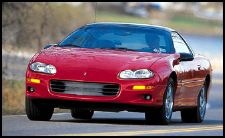
In the end, then, the Z28 takes another round in this ongoing rivalry and continues to be one of the best performance buys on the planet. But the Mustang continues to hold the edge in the one department that really matters. Despite the Camaro's big edge in zoom, the Mustang outsells the Camaro and Firebird combined, and by a bunch: 116,610 to 88,497 in 1997; 120,901 to 69,389 through 10 months of 1998. The addition of more power and refinements for 1999 can only help, and developments such as a new independent rear suspension—due to debut this spring on the SVT Mustang Cobra—indicate that Ford sees a future for the pony car. What GM sees is a mystery. Highs: Face-distorting thrust, slick good looks, six-speed gearbox. Lows: Ponderous feel, choppy ride, poor seating. The Verdict: Dated in a number of ways, but still an untouchable blast for the bucks.
How Do the V-6s Shape Up?
Back |
|
|
|
|
